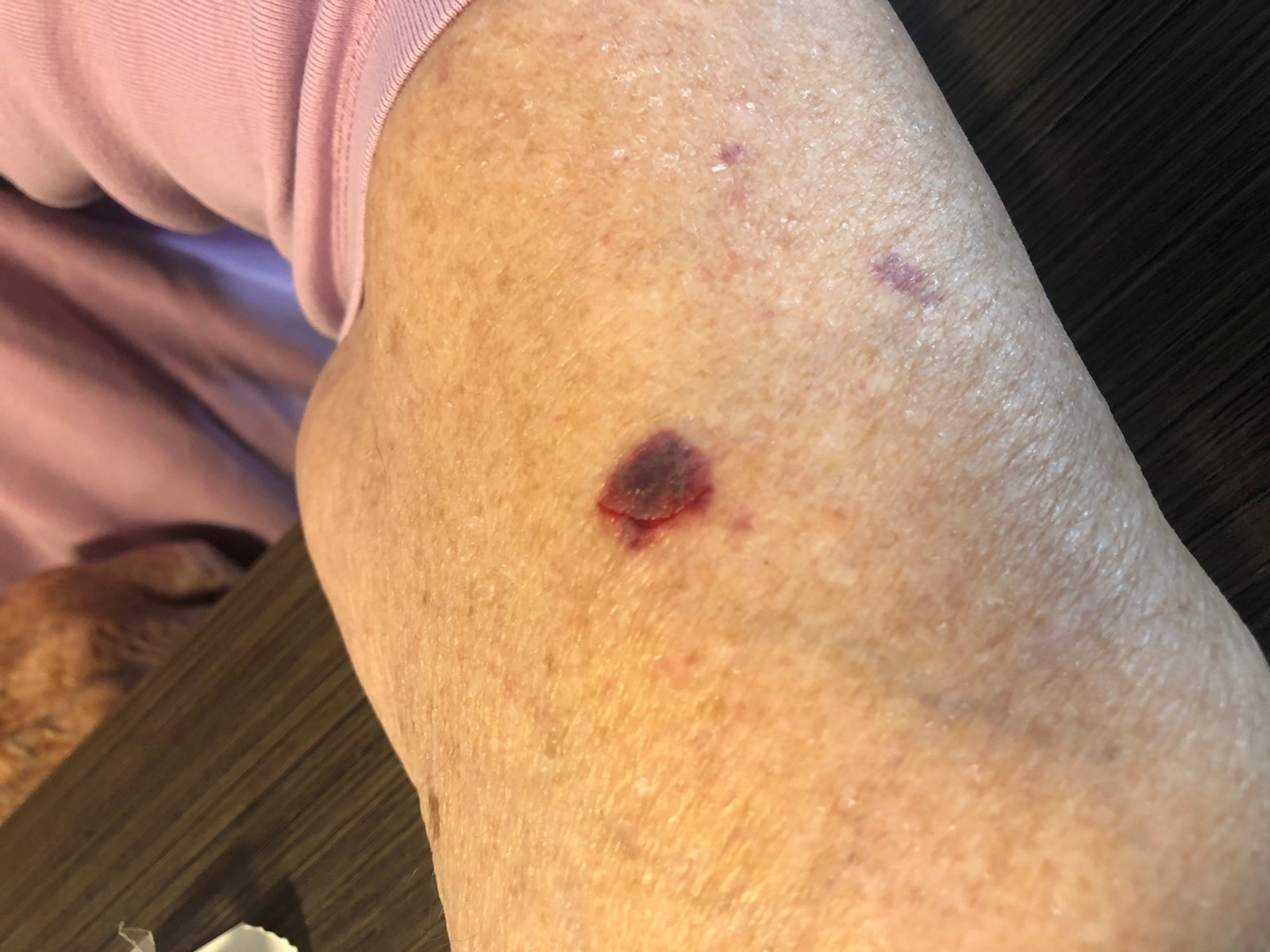Erhalten Sie vollen Zugriff mit einem kostenfreien Konto
Vorteile von Coloplast® Professional
![]() Erhalten Sie vollen Zugriff auf alle Inhalte, Veranstaltungen und Materialien
Erhalten Sie vollen Zugriff auf alle Inhalte, Veranstaltungen und Materialien
![]() Verfolgen Sie Ihren Fortschritt
Verfolgen Sie Ihren Fortschritt
![]() Teilen Sie unterstützendes Material mit Ihrem Patienten
Teilen Sie unterstützendes Material mit Ihrem Patienten
![]() Teilen Sie Inhalte mit Ihren Kollegen
Teilen Sie Inhalte mit Ihren Kollegen
Understanding skin tears
In this section, you’ll learn:
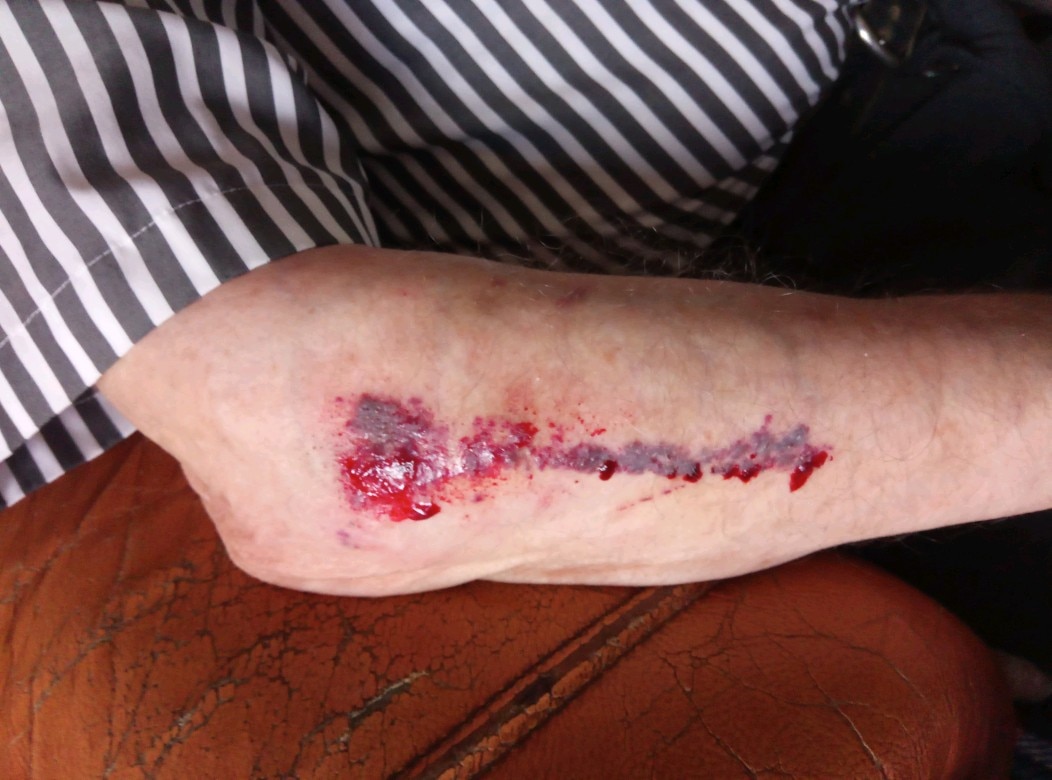
Was sind Skin Tears?
Übersetzt bedeutet Skin Tear „skin “ = Haut und „tear “ = Riss, Einriss, d.h. Skin Tear = „Hautriss“. Skin Tears sind daher Hautverletzungen, die durch eine mechanische Kraft, wie etwa Scherkräfte oder Reibungen, verursacht werden können. Sie können aber auch durch ein Entfernen eines stark haftenden Verbands entstehen.1 Ältere Menschen mit fragiler Haut, Neugeborene und Menschen mit Cortisonhaut sind am häufigsten von Skin Tears betroffen.1
Diese traumatischen Wunden können zu einer teilweisen oder vollständigen Ablederung der äußeren Hautschichten (Epidermis und Dermis) führen. Sie können auch zu einem Ablösen der Epidermis und der Dermis von dem darunter liegenden Gewebe führen. Die Schwere dieser Hautverletzungen variieren je nach Tiefe der Wunde.1
Skin Tears können an jedem Körperteil auftreten, jedoch entstehen sie meistens an Extremitäten, wie Arme, Beine und Handrücken.1
Did you know?
While some might refer to skin tears as a “laceration”, a skin tear is a specific injury that is very different from a general laceration. A laceration involves soft tissue tearing.1
Klassifizierung von Skin Tears
Skin Tears unterscheidet man in drei Arten. Die Art des Hautrisses wird dadurch bestimmt, wie stark der Verlust des Hautlappens ist. 2 The “flap” is the part of the skin (either the epidermis or dermis) that is separated from its original place by shear, friction and/or blunt force.2
Tabelle 1: Klassifizierung von Skin Tears1
|
Typ1 |
Beschreibung1 |
Beispiel1 |
|
Typ 1: Kein Gewebeverlust |
Ein Hautriss von Typ 1 ist ein gradliniger Hautriss. Bei dieser Wunde kann der Hautlappen wieder so angelegt werden, sodass das Wundbett abgedeckt wird. |
|
|
Typ 2: Teilweiser Gewebeverlust |
Bei einem Hautriss vom Typ 2 löst sich der Hautlappen teilweise. Dies bedeutet, dass der Hautlappen nicht neu positioniert werden kann, um das gesamte Wundbett abzudecken. |
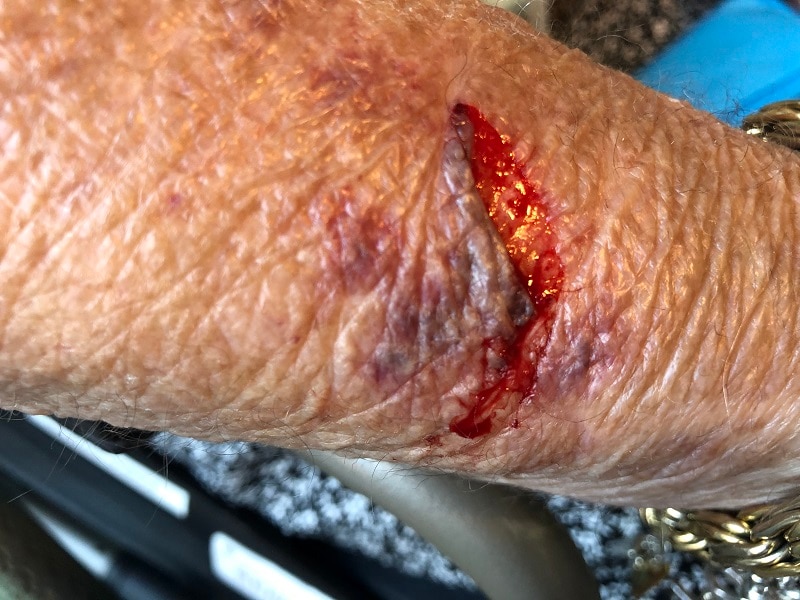 |
|
Typ 3: Vollständiger Gewebeverlust |
Bei Skin Tears Typ 3 löst sich der Hautlappen komplett. Das Wundbett liegt vollständig offen. |
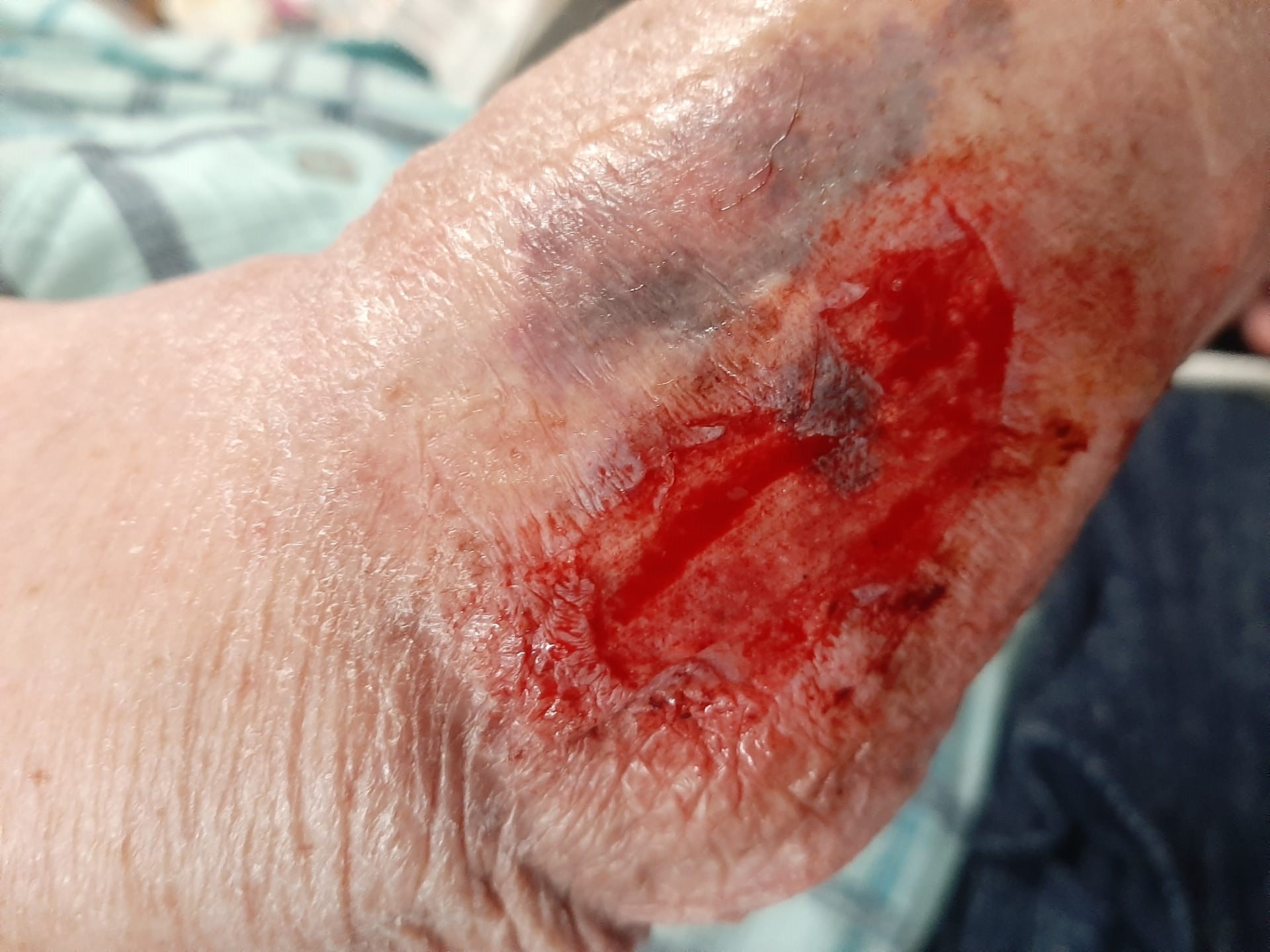 |
Who is at risk of getting a skin tear?
Our skin is the body’s first line of defense. It acts as a protective barrier and prevents damage to our internal tissues and organs. However, if our skin becomes frail or fragile, it’s more likely to be damaged. This increases the risk of skin tears, as less force is needed to cause a traumatic injury.2
While skin tears can happen in a variety of patients, the elderly population is, particularly at risk. As we age, our skin becomes more fragile. The skin’s ability to heal itself slows down, which can make it even more vulnerable to skin tears.2 (See Figure 1 for more information)
If an elderly patient needs help to carry out daily tasks, such as moving around or washing, this can increase the risk of skin tears. Additionally, elderly patients who have other illnesses, are undergoing certain medical treatments (e.g. chemotherapy) or are on certain medications (e.g. steroids), can have an even higher risk of developing skin tears.1
Figure 1: How our skin changes as we age1
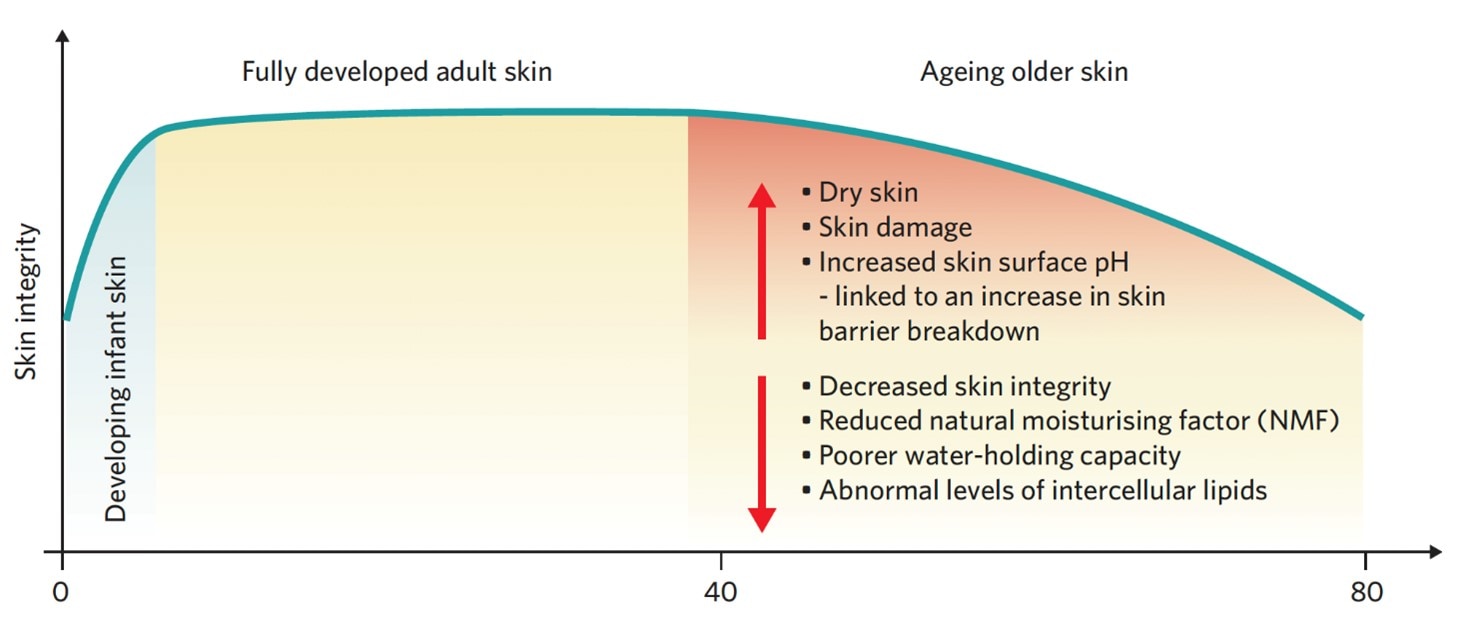
Individuals who are at risk of skin tears2
Although skin tears are the most common wound amongst elderly patients, there are several patient groups with vulnerable skin, including:
- individuals with mobility issues or paralysis
- children and neonates
- bariatric patients
- oncology patients
- individuals with spina bifida and cerebral palsy
How do I prevent skin tears in my patient?
To prevent your patient from getting a skin tear, you can take two steps. One, find out if your patient is at risk. And two, take steps to minimise your patient’s risk. Let’s look at two tools that can help you to do this.
Tool #1: The Skin Tear Risk Assessment Protocol
To find out if your patient is at risk, you can use the Skin Tear Risk Assessment Protocol (See Figure 2).1
This protocol looks at three main risk factors:
- skin,
- mobility, and
- general health.
Figure 2: Skin Tear Risk Assessment Protocol1
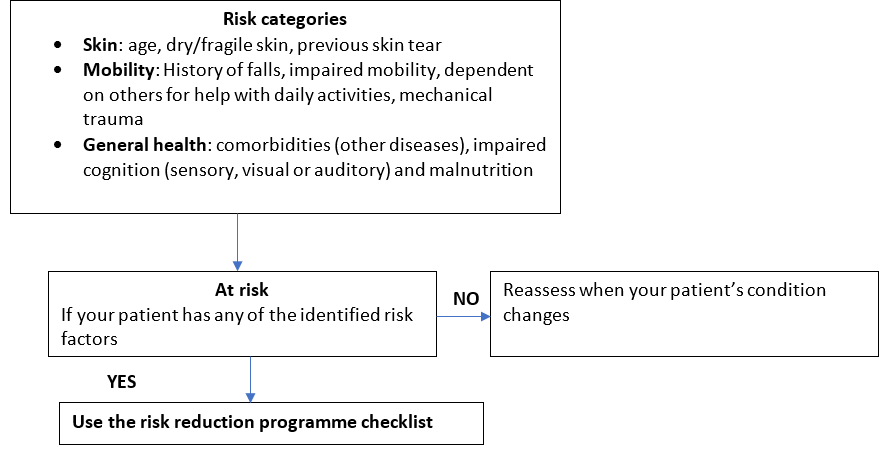
Tool #2: The Risk Reduction Programme Checklist
If you find out that your patient is at risk, use the Risk Reduction Programme Checklist (See Table 2). This will help you protect your patient from skin tears. The checklist gives you a list of tips and suggestions based on the same three factors as the risk assessment: skin, mobility, and general health. By controlling the risk factors around your patient, you can help them maintain skin health and avoid injury.1
Did you know?
Using emollients promotes general skin health. Studies have shown that by applying an emollient twice a day, you can reduce the incidence of skin tears by 50%.1
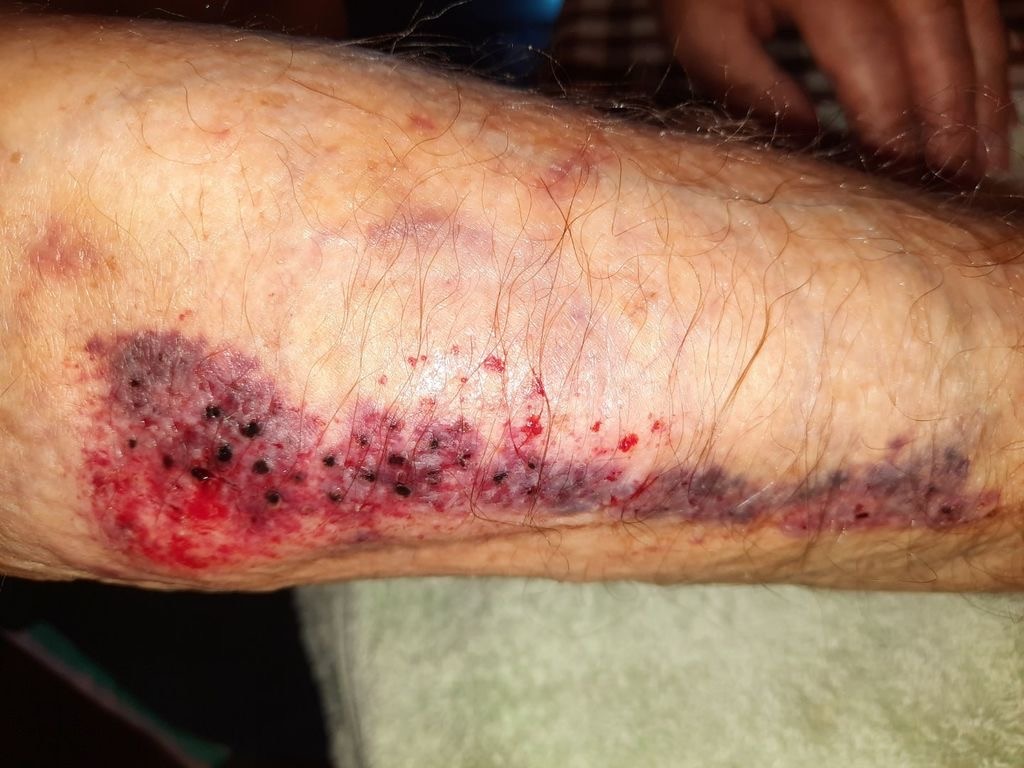
Take a holistic approach to risk assessment
When you assess your patient, it’s important to consider the patient’s entire situation, including their complete medical history, mobility, nutritional status, economic and social factors. We call this the holistic approach to assessment. One tool that can help you do that is The Triangle of Wound Assessment. You can read more about this tool and how to use it here.
Risk reduction programme checklist
Risk factor: Skin
What you should do:
- Assess the skin and find out if the patient has had skin tears in the past.
- If your patient has dry, fragile, or vulnerable skin, assess the risk of accidental trauma.
- Manage dry skin and use emollient to rehydrate the skin.
- Create an individualised skincare plan using a skin-friendly cleanser (not traditional soap) and warm (not hot) water.
- Use silicone tape and cohesive retention bandages to Prevent skin trauma from adhesives, dressings, and tapes.
- Consider medications that may directly affect the skin (e.g. topical and systemic steroids)
- Be aware of increased risk to due age extremes (e.g. very young or elderly)
- Talk about using protective clothing (e.g. shin guards, long sleeves or retention bandages)
Avoid sharp fingernails or jewelry when you’re in contact with your patient.
Risk factor: Mobility
- Encourage your patient to be active and exercise
- Avoid friction and shearing when you’re moving the patient.
- Use good manual handling techniques (check your local guidelines)
- Conduct a falls risk assessment
- Make sure your patient wears sensible/comfortable shoes
- Carefully put on clothing and compression garments
- Make sure the environment is safe (e.g. remove any obstacles that the patient could trip over or run into)
- Use padding for equipment and furniture
Assess for potential skin damage from pets.
Risk factor: General health
- Teach the patient and carers about how to prevent skin tears
- Actively involve the patient and carers in decisions
- Optimise nutrition and hydration (refer to a dietician if needed)
- Refer to an appropriate specialist if the patient has problems with sensory perception (e.g. diabetes)
Consider how medication and polypharmacy might affect the patient’s skin.
For more information on how to avoid skin injuries in bedbound patients, read this article
Quellenangaben:
- ISTAP Best Practice Recommendations for the Prevention and Management of Skin Tears in Aged Skin 2018
- ISTAP Best Practice Recommendations for Holistic Strategies to Promote and Maintain Skin Integrity 2020

